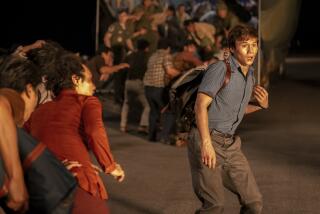‘You Can Feel Death Chasing You’ : Daring Swim From Vietnam Isle Leads Sailor Nowhere
- Share via
PUERTO PRINCESA, Philippines — Officially, Tran Van Khinh is not a “boat person.” He had no boat. So he swam.
The powerfully built 23-year-old Vietnamese sailor, desperate to escape a life of misery under a brutal regime, slipped off his uniform one night last year while on guard duty on a remote, Vietnamese-held island in the Spratly chain in the South China sea. He threw his AK-47 assault rifle into the sand and jumped into the ocean.
For four hours straight, he swam through open water thousands of feet deep, filled with sharks and patrolled by the navy he was fleeing. He swam until his arms felt like rubber, until he felt near death, but he kept swimming, he said, because, “When you stand between life and death itself, you can feel death chasing you, and it takes away the exhaustion.
“You can only feel tired when you reach freedom.”
Tran Van Khinh still hasn’t reached freedom, but he is growing tired of trying.
Son of Army Officer
Although he is the son of a South Vietnamese army officer who served with the U.S. forces in Vietnam, and despite his death-defying escape from a regime he had fought against since he was a teen-ager, the U.S. Immigration and Naturalization Service rejected Tran Van Khinh for resettlement in the United States because he, like thousands of other Vietnamese refugees now stranded throughout Southeast Asia, did not fit America’s increasingly strict and sometimes confusing guidelines for permanent resettlement of the new wave of “boat people.”
Tran Van Khinh was disqualified for two reasons: He did not escape by boat and therefore is not a “boat person,” and he served in the People’s Army of Vietnam under the current Communist regime in Hanoi.
Trapped in Labyrinth
Khinh’s escape may have been unique, but his plight is not. When he washed up on the shores of the Philippines, Khinh joined the ranks of tens of thousands of new refugees who are trapped in a confusing and often-conflicting bureaucratic labyrinth.
Many who have been rejected by the U.S. government are considered economic refugees, fleeing Vietnam’s devastated economy rather than political persecution. Others, like Khinh, were rejected for political reasons under guidelines that are grounded in U.S. policy to resettle only those Vietnamese who worked in the government before 1975 and reject those who served after the U.S. involvement there ended.
But, like dozens of other refugees interviewed by The Times in the now overflowing refugee camps in Hong Kong, Thailand and the Philippines, it was not by choice that Khinh served in the Vietnamese People’s Army. He was drafted against his will.
Escaped Draft Twice
Because of his father, Khinh said, he had grown up as a second-class citizen in postwar Saigon. Sharing his father’s beliefs, Khinh said he successfully escaped his draft notice twice. On the third time, soldiers came to his home and found him hiding under the bed.
Most such draftees are assigned either to remote posts or to the Thai-Cambodian border, where they must fight three Cambodian guerrilla armies, according to many of the recent Vietnamese refugees who said they fled to escape the draft and the war front.
In Khinh’s case, he was drafted into the navy and assigned to a contingent of 160 enlisted men on the isolated island of Song Tu Tay, one of nine tiny islets and reefs occupied by Vietnam in the Spratly Island chain, specifically because his superiors suspected that he would try to escape again.
On July 29 of last year, after weeks of careful planning, Khinh did. His marathon swim took him to the Philippine-occupied Spratly island of Parola about 3 miles away, where Philippine navy officers rescued him and sent him to the Philippines’ first-asylum camp for “boat people” here in Puerto Princesa.
Rejected by U.S.
It was at this camp that U.S. immigration officials decided to reject Khinh for resettlement.
The camp, located on the Philippine island of Palawan, has a good record of resettlement. Most of the “boat people” who land in the Philippines are from southern Vietnam, many of them former South Vietnamese soldiers and inmates of re-education camps, who are among the most eligible for American resettlement.
But, in the recent tidal wave of “boat people,” there are many more like Khinh, refugees who are fleeing Vietnam either for economic reasons or who fled for legitimate political reasons but simply have fallen through the expanding holes in the safety net that the United States and other Western nations created after the fall of Saigon in 1975.
“There is no question the Americans are tightening up on resettlement,” said one camp official in Puerto Princesa. “Ten years ago, a guy like this swimmer would have been an American within months. Now, things are getting stricter, and guys like this are falling through the cracks.”
‘I Can’t Go Anywhere Else’
Contemplating his future, a process now common among the tens of thousands of recent Vietnamese “boat people” who are languishing in camps throughout the region with little else to do, Tran Van Khinh just stared blankly at a visiting reporter.
“Please, maybe you can tell me,” he said finally, adding that his father remains under tight government surveillance in Vietnam after 10 years in a re-education camp. “I have turned my back on my nation, on my past, and I have left my family and everything I was behind me. I cannot return. . . . They’ll kill me. And yet I cannot go anywhere else.
“The U.S. delegation that interviewed me told me they were deeply moved by my action. But they said I was a very special case because I came without a boat and I was in the army of the Communist government of Vietnam.
“Now, I am no longer in that army. I am no longer in that country. Now, I am nowhere.”
More to Read
Sign up for The Wild
We’ll help you find the best places to hike, bike and run, as well as the perfect silent spots for meditation and yoga.
You may occasionally receive promotional content from the Los Angeles Times.






